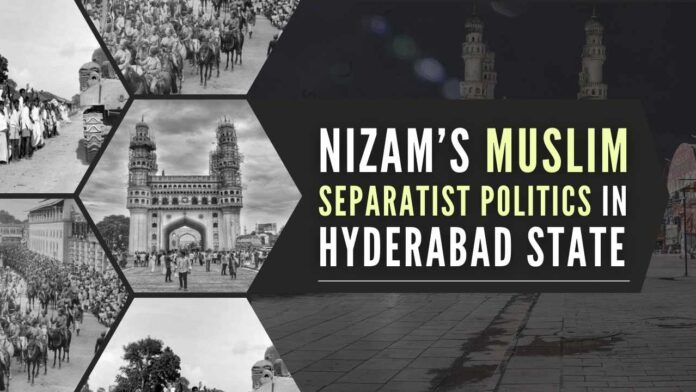
How Hyderabad was liberated on 17th Sep 1948
This year marks the beginning of the commemoration of Hyderabad Liberation which culminates in its 75th anniversary next year in 2023, a year later than the rest of the country. Many Indians are still not aware that Hyderabad was liberated on 17th September 1948, by the 5-day Police Action code-named ‘Operation Polo‘ undertaken by the Indian Army as directed by Sardar Patel, the then Home Minister of independent India.
Hyderabad was the largest state in undivided India, ruled by the Muslim fundamentalist Nizams in an overwhelmingly Hindu majority population. The hegemony of 10% Muslims over 90% Hindus was the Nizamia order of the day. Hyderabad state was the biggest with 16 districts, a 1.64 crores population in an area of 42000 sq. miles or 2 crores 67 lakh acres. It consisted of the then eight districts of Telugu speaking Telangana region – Warangal, Karimnagar, Nizamabad, Adilabad, Mahbubnagar, Medak, Nalgonda, and Atraf-a-Balda District meaning Hyderabad town and adjoining areas. About 84 lakh people lived in this region as per the 1941 census. As per the same census, about 50 lakh Maharashtrians lived spread over five districts of Aurangabad, Bheed, Parbani, Nanded, and Osmanabad; and about 30 lakh Karnataka people lived in the three districts of Gulbarga, Raichur, and Bidar.
When the rest of India was hoisting the tri-color in August 1947 celebrations reverberated with Vande Mataram, Bharat Mata ki Jai, Swatantra Bharat ki Jai, Hyderabad state was still shouting `Azad Hyderabad, Shahe Osman Zindabad, Quaid-e-Millat Siddique Kasim Razvi Zindabad’. The seventh and last Nizam of Asaf Jahi’s, Mir Osman Ali Khan had ambitions of holding Hyderabad as an independent Islamic state like Pakistan or Turkey. He was extremely servile to the British hoping that they would support him in his ambition of `Azad Hyderabad’ which was tentatively called `Osmanabad’. Nizam sent a letter to United Nations Organization and also requested Britain to help him retain independent Hyderabad. He had sent generous amounts of funds and gifts to Pakistan and other Arab countries in the hope that they would render him timely support. To put more pressure and make the situation untenable, he instructed the Razakars and police, all Arab, Rohilla, Pathan, and Kutchi Muslim refugees who were settled in Hyderabad, to increase the violence multifold all over Hyderabad state and at the borders of adjoining states of Indian Union. He also encouraged the communists in their armed rebellion to fight against the Indian Union.
Suppression of Hindu Dharma, culture, and languages- Destruction of temples
Much has been said and written on the Nizam’s militia, the razakars, who together with the Nizam state police had unleashed massive atrocities against Hindus in the erstwhile Hyderabad state. The many massacres including Bhairavunipalle, Gorta, and the burning of Brahmins, come to mind. Genocidal killings of an estimated 100,000 Hindus are given, but experts opine that the number is far higher.
The atrocities of Razakars in the erstwhile Hyderabad state were unprecedented in severity and scale; they massacred Hindus, raped women, looted lakhs of rupees and assets, razed their houses to the ground, and threw the people into the burning fires of their own houses. Weapons were hidden in the mosques, and wherever they felt the Hindu community was becoming stronger, they would attack them. When desperate Hindus wanted to flee from their own properties and homes, they were prevented from fleeing as the Nizam govt needed labor to work in the fields to produce crops and generate revenues, which would be once again confiscated from them.
Nizam conducted religious, cultural, and language destruction brazenly. Razakars demolished temples, broke the idols of Deities, buried them in the mud, stole the ornaments on the deities, and no new temples were allowed to be constructed. Muslim graveyards were built adjacent to temples. Countless masjids, dargahs, and tombs were constructed not only for royalty but also for their harems. Hindu festivals were not allowed to be conducted, Ganapati or Vijayadasami processions and celebrations were ruthlessly suppressed, if anyone dared to take out a procession, the Razakars and police would enter, shoot mercilessly and make people run for their lives.
The cultural suppression of native languages was extreme, Nizam never encouraged or supported the Telugu language in any manner whatsoever. In a 95% Telugu-speaking region, Telugu was not allowed to be taught in schools, if they ever found a Telugu book, that book would be torn apart. After the establishment of Osmania University in 1918, with Urdu as the medium of instruction even at the university level with all professional courses in Urdu, the Telugu language was even more severely suppressed.
Nizam’s Muslim fundamentalism
Mir Osman Ali Khan, the VII and the last Nizam of Hyderabad, till his last day in power as a king, continued to be a communal bigot and a religious fanatic. Reflecting his bigoted mindset, the Nizam expressed his views in a verse in the newspaper `Rahbare Daccan’ as follows:
`Bande naa khoon huva sunke nidaaye takbeer
Jalajala hi ahi gayaripta yejunnarmebhi.’
`The conch became silent with the sound of kalma
The mud from the quaking earth covered the sacred thread and other symbols of the Hindus’.
Deendar religious movement
The Nizam started the Deendar organization, an Islamic religious movement in 1929 headed by Siddique Deendar, who canvassed that as per the old `Kalagnyanam’, Nizam is an avatar of Panduraju, that a `Dharmayuddha’ is on and hence people should join Nizam’s religion. He even said verses of appreciation of Nizam are there in the Vedas, Puranas, and in Quran Hadis.
“Wake up, arise, and fight against betrayers, I am ordering as the Commander in this religious war; there will be conflicts and skirmishes in the Deccan, all Muslims will join together under a common Nizamia flag and will establish their own kingdom. In the year Hijri 1367, Islamic soldiers will get ready to wage a religious war. They will join forces with a king named Osman. It is written by great men in their prophesies that `All Hindus will become Muslims, the deities in the Hindu temples will be shattered and broken into pieces’. I’m ordering as a religious leader, read the Kalma, all Hindus – you all come to me, your savior has arrived, the great king is ordering you all to join him, adhering to my instructions will bring you Mukthi”.
Majlis Ittehadul Muslameen’ (MIM)
The Nizam established the Majlis Razakar religious militia; the word Razakar actually means voluntary peace workers or `peace army’. `Majlis Ittehadul Bainulmuslameen’ formed in 1926 and became Majlis Ittehadul Muslameen’ (MIM) in 1929.
Bahadur Yar Jung, a high-ranking official in the `Religious Dept’ of the Nizam administration was MIM’s first president. From then onwards, Nizam’s military police and the MIM’s Razakar army worked together. Bahadur Yar Jung studied Islamic religious invasions and expansionism and gave frequent appealing and rousing speeches combining these medieval exploits with the tenets of the Quran. Razakars, the band of supporters in hundreds of villages, during 1935-1948 created unprecedented violence, demolished temples, and committed unspeakable atrocities against the Hindus. Khasim Razvi became President of MIM in 1944; the Razakars moved with swords and guns openly in trucks, and attacked and terrorized people.
Donations to Muslim agendas
Nizam’s religious megalomania to convert Hyderabad into an Islamic state was unprecedented. The religious fanaticism of Nizam made him donate to Muslim organizations not only in India but to far-off regions such as Mecca Madina, Turkey, Palestine, Iraq, Basra, etc. The revenues generated from the poor impoverished Hindu labor in Hyderabad state were donated to the following Muslim organizations:
- Renovating and flooring of Delhi Jama-masjid.
- Aligarh Muslim University.
- Mujavars in Ajmer.
- Muslim women suffering from famines in Bhavanagar.
- Muslim soldiers wounded in Balkan wars.
- Mohammadan school in Berar.
- Masjid construction in Basra.
- All-India Mohammadan Educational conference.
- Osmania building construction in Aligarh college.
- Ambala Muslim high school.
- Kanpur Muslim High school.
The list is only till 1920, he continued to donate to Muslim organizations till 1948. Nizam sent Rs.20 crores to Mohammad Ali Jinnah and declared that his heart is in Pakistan.
Muslim separatist agenda
As events started unfolding leading to Indian independence, MIM set forth its demands for Hyderabad to remain a permanent Muslim-ruled state.
-
-
- Hyderabad state should be a full-fledged independent monarchy. A Muslim member of the Asaf Jahi dynasty shall be the king always.
- If Hyderabad state has to necessarily join the Indian federal system, there should be no lapse in the complete political and financial power of the Hyderabad Nizam.
- Urdu should remain the state’s official language as well as the language of education in schools and universities.
- In the future, if any changes are made to the constitution, it should not hamper the political growth of Muslims; Deccan Muslims would never agree to the changes otherwise.
1. Muslims should be in majority in the assemblies and local bodies.
2. Muslim seats should be filled with candidates from separate electorates. -
With the brute strength of the Razakar bands of militia and support from the British, Nizam aimed to build his own Pakistan in the heart of India. Mohammad Ali Jinnah came to Hyderabad in 1947 and made many provocative statements in a public meeting, `we will break the Hindus like chicken necks. We will cut them like radish’ which put the Razakars on an even more aggressive mode. In the banquet hosted by the Nizam to bid farewell to the British Resident, the Nizam declared that he is independent, “I have already spoken on 12th June, and on 14th July 1947 about the problems which would follow Indian independence. I am reiterating that I’m an independent ruler, and now with the British leaving, I am declaring that I will be a totally independent sovereign”.
Postscript
K M Munshi, the Agent General of India in Hyderabad, in his `Pilgrimage to Freedom’ recounted his experiences of those tumultuous days. He spoke of Prime Minister Nehru’s extreme reluctance and annoyance in taking any action against the Nizam and integrating Hyderabad state into the Indian Union. Ultimately Sardar Patel’s action integrated Hyderabad state into the Union.
However, in a strange development of events, the Muslim separatist politics of Hyderabad state was never sought to be changed by the Govt of India or the Congress govt formed in Hyderabad state. The Nizam and his courtiers escaped all punishment for their brutal genocidal crimes, the Nizam continued as Raj Pramukh of the state and retained all his massive properties, palaces, mansions, money, gold, jewelry, and precious stones. The several trusts formed by the Nizam with people’s money, which were handed over to Razakars and other aides were never recovered. The Nizam police which killed and terrorized Hindus were absorbed into the Hyderabad state police, and all the Nizam revenue officials who looted and plundered Hindus were also absorbed into the Hyderabad state administration. Razakar chief Khasim Razvi was convicted for his gruesome inhuman crimes, and yet after serving a jail term was released in 1957 and a safe passage to Pakistan was arranged for him. The MIM party handed over to Abdul Wahid Owaisi by Razvi before he left for Pakistan also continues as a Muslim political party and the leadership of the party too continues in the same family. The Muslim names of several towns and districts including Hyderabad have never reverted to their original Hindu names.
Inputs are taken from Sri Kasireddy Venkatareddy’s book “Nizams Rule Unmasked”, Samvit Prakashan.[1]
Note:
1. Text in Blue points to additional data on the topic.
2. The views expressed here are those of the author and do not necessarily represent or reflect the views of PGurus.
Reference:
[1] Nizams’ Rule Unmasked – HindueShop
PGurus is now on Telegram. Click here to join our channel and stay updated with all the latest news and views
For all the latest updates, download PGurus App.








